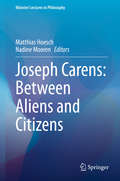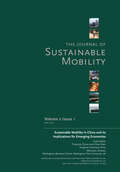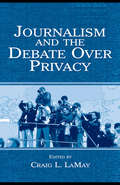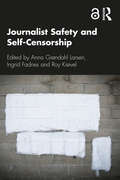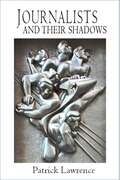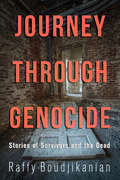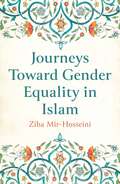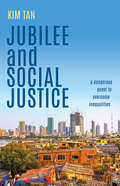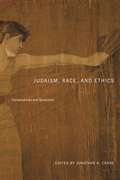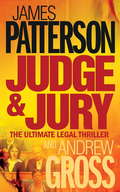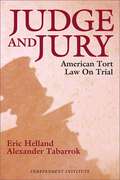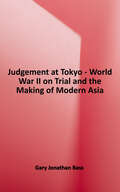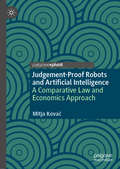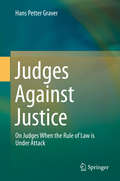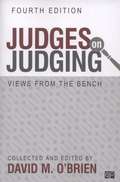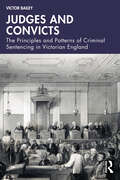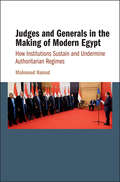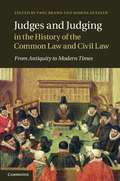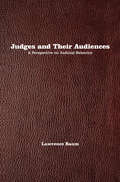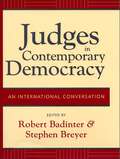- Table View
- List View
Joseph Carens: Between Aliens and Citizens (Münster Lectures in Philosophy #6)
by Matthias Hoesch Nadine MoorenThis book offers a critical discussion of Joseph Carens’s main works in migration ethics covering themes such as migration, naturalization, citizenship, culture, religion and economic equality. The volume is published on the occasion of the annual Münster Lectures in Philosophy held by Joseph Carens in the fall of 2018. It documents the intellectual exchange with the well-known philosopher Joseph Carens by offering critical contributions on Carens’s work and commentaries of Carens as a reply to these critical contributions. With his various works on migration ethics, Joseph Carens must be seen as one of the leading academics in the political and ethical discourse of migration in the last years. The topic of migration raises questions not only regarding naturalization and citizenship but also cultural, economic and religious differences between aliens, citizens and persons whose status lies in between and calls for further determination. Such questions gain more and more importance in our globalized world as can be seen for example in the context of the refugee crisis in the European Union and the U.S. The book covers different systematic topics of Carens’s work as can be found in his widely read book “The Ethics of Immigration” but also in further publications. It provides papers with critical discussions of Carens’s work as well as his responses to these, thus enabling and documenting the fruitful dialogue between the contributors and Carens himself. The aim of this book is to sharpen and shed light on Carens’s arguments concerning migration by offering new and critical perspectives and fine-grained analyses.
Journal of Sustainable Mobility Vol. 2 Issue 1: Sustainable Mobility in China and its Implications for Emerging Economies
by Michael Zhang Fuquan Zhao Han HaoAfter three decades of rapid economic growth, China became the world’s second largest economy in 2010 after the United States of America. Along with the prospect of lifting millions out of poverty and improving living standards, China is facing yet new challenges of rapid urbanization. Recent research findings show that in 2012 urbanization rate was 52.6% in China (Lacy et al., 2013). It is predicted that by 2020 the number of megacities in China with an urban population of more than 10 million will increase to thirteen. Along with the increase in urban population and living standards there has been rapid increase of car ownership in China. It is estimated that there are more than five million vehicles in Beijing (Cheng, 2013; Economist, 2013). Large cities and prefecture-level cities already contributed 89.6% of China’s total industrial CO2 emissions. One day in January 2013 air in Beijing was heavily polluted to a level of toxicity (smog) forty times the standard safe level set by the World Health Organization (Economist, 2013).At the international level, transport contributed 61.5% to world petroleum consumption and 22.3% to global CO2 emissions in 2010 (IEA, 2012). While the overall level of CO2 emissions in developed economies is stabilizing and in some cases declining, the levels in the developing and emerging economies are increasing. Large emerging economies with megacities will imminently become the major concerns of transport-related CO2 emissions. Without strategic innovations in the automotive industry and transport management system the current state of China’s transport sector is not sustainable. The long-term sustainable solutions are likely to emerge from the interplay of economic, environmental, social and technological factors.The Special Issue, partnered with the Second International Symposium on Sustainable Mobility, focuses on the issues of developing policies and corporate strategies to help the automotive industry, transport management systems, and urban planning to embark on a sustainable path to future growth and development (WBCSD, 2007; World Bank, 2008). The critical debate and research findings of this issue shed light on future research and practice on sustainable mobility in emerging economies.
Journalism and the Debate Over Privacy (Routledge Communication Series)
by Craig L. LaMayJournalism and the Debate Over Privacy situates the discussion of issues of privacy in the landscape of professional journalism. Privacy problems present the widest gap between what journalism ethics suggest and what the law allows. This edited volume examines these problems in the context of both free expression theory and newsroom practice. Including essays by some of the country's foremost First Amendment scholars, the volume starts off in Part I with an examination of privacy in theoretical terms, intended to start the reader thinking broadly about conceptual problems in discussions about journalism and privacy. Part II builds on the theoretical underpinnings and looks at privacy problems as they are experienced by working journalists. This volume features discussion of: *privacy as a socially-constructed right--a moving target that changes with technology, social norms, national experience, and journalistic practice; *privacy as both a property and a commercial right; *privacy in terms of journalism ethics and journalistic codes; *privacy as an attribute of press independence from government; and *Bartnicki v. Vopper and its implications for journalism. With this volume, editor Craig L. LaMay provides a concise, intellectually provocative overview of a topic that is of growing importance to journalists, both legally and ethically. The work is intended for scholars and advanced students in communication law, ethics, and First Amendment rights, and is also appropriate for First Amendment and media law classes in law schools.
Journalist Safety and Self-Censorship
by Ingrid Fadnes Anna Gr Roy KrThis book explores the relationship between the safety of journalists and self-censorship practices around the world, including local case studies and regional and international perspectives. Bringing together scholars and practitioners from around the globe, Journalist Safety and Self-Censorship provides new and updated insights into patterns of self-censorship and free speech, focusing on a variety of factors that affect these issues, including surveillance, legislation, threats, violent conflict, gender-related stereotypes, digitisation and social media. The contributions examine topics such as trauma, risk and self-censorship among journalists in different regions of the world, including Central America, Estonia, Turkey, Uganda and Pakistan. The book also provides conceptual clarity to the notion of journalist self-censorship, and explores the question of how self-censorship may be studied empirically.Combining both theoretical and practical knowledge, this collection serves as a much-needed resource for any academic, student of journalism, practicing journalist, or NGO working on issues of journalism, safety, free speech and censorship.
Journalists and Their Shadows
by Patrick LawrencePART MEMOIR, PART SOCIAL HISTORY, Journalists and Their Shadows captures the deplorable state of the American media in our time—recording its deterioration, its moments of crisis, and ultimately, its transformation as seen through the eyes of a journalist engaged at its very heart through all its phases. The press had a bad Cold War, Patrick Lawrence contends, and never recovered from it, having never acknowledged its errors and so unable to learn from them. Its dysfunctional relationship with the national security state today is strikingly reminiscent of how it was in the Cold War’s earliest days. With remarkable fidelity, all the old errors are being repeated. As a result, the mainstream American media have entered into a period of profound transformation, in the course of which independent media are emerging as the profession’s most dynamic sector—and represent, indeed, the promise of a brilliant future. A weave of three elements, Lawrence’s book offers a searing cultural and political critique, punctuated by the kind of piquant detail only insiders can provide. He also makes the case for a way forward—an optimistic case based on the vitality now apparent among independent media. Here, too, he is at home, providing the book’s most original coverage of this brave new world. He draws upon many years in the profession, a multitude of mainstream outlets ranging from his decades as foreign correspondent for the venerable International Herald Tribune to his work now as a columnist for a similar wide range of alternative news outlets such as Counterpunch and Consortium News. 'Shadows' probes the psychological dilemma that must be understood if we are to address the current crisis. Journalists in our time are divided within themselves—driven to meet thoroughly professional but ideologically conformist standards, but on the other, subliminally struggling to breach the barriers that preclude the truths they know should be conveyed. This latter, as Jung has put it, is the journalist’s shadow. Shadows’ case for the reintegration of the divided journalist is striking and original. This record of the American media’s increasingly shabby betrayal of the public trust sheds light on why the American public thought and thinks the way it does, how it has become aware that the truth it seeks is absent, and where and how it may yet be able to ferret it out. Here is a guide to the future, in fact, of journalism itself.
Journey through Genocide: Stories of Survivors and the Dead
by Raffy BoudjikanianPowerful accounts by genocide survivors, a journalist seeking to bear witness to their pain. Darfuri refugee camps in Chad, Kigali in Rwanda, and the ruins of ancient villages in Turkey — all visited by genocide, all still reeling in its wake. In Journey through Genocide, Raffy Boudjikanian travels to communities that have survived genocide to understand the legacy of this most terrible of crimes against humanity. In this era of ethnic and religious wars, mass displacements, and forced migrations, Boudjikanian looks back at three humanitarian crises. In Chad, meet families displaced by massacres in the Darfur region of neighbouring Sudan, their ordeal still raw. In Rwanda, meet a people struggling with justice and reconciliation. And in Turkey, explore what it means to still be afraid a century after the author’s own ancestors were caught in the Armenian Genocide of 1915. Clear-eyed and compassionate, Boudjikanian breathes life into horrors that too often seem remote.
Journeys Toward Gender Equality in Islam
by Ziba Mir-HosseiniIf justice is an intrinsic value in Islam, why have women been treated as second-class citizens in Islamic legal tradition? Today, the idea of gender equality, inherent to contemporary conceptions of justice, presents a challenge to established, patriarchal interpretations of Shari&‘a. In thought-provoking discussions with six influential Muslim intellectuals – Abdullahi An-Na&’im, Amina Wadud, Asma Lamrabet, Khaled Abou El Fadl, Mohsen Kadivar and Sedigheh Vasmaghi – Ziba Mir-Hosseini explores how egalitarian gender laws might be constructed from within the Islamic legal framework.
Juan Valdéz. La estrategia detrás de la marca
by Varios AutoresLa estrategia para posicionar a una de las marcas más icónicas del país. Juan Valdez, su mula Conchita y el paisaje montañoso son la imagen del café colombiano en el mundo. Estos tres íconos han impulsado la imagen del café colombiano y a lo largo de 50 años de existencia, han sufrido una serie de transformaciones que han ayudado a que hoy se reconozca el café colombiano como el más rico del mundo.
Jubilee and Social Justice: A Dangerous Quest to Overcome Inequalities
by Tan, Kim“Impact Investor” Kim Tan challenges the church to ask whether or not the gospel as we interpret it today really embodies the jubilee vision of the Bible. Imagine a group of forty adults living in a community, assisting each other to buy houses, sharing material wealth and releasing the surplus to help others as a practical outworking of the biblical principles of jubilee. Kim Tan was part of this group who defined principles of sacrificial generosity, stewardship, and social holiness.This book is in two parts. First it walks through the Old Testament on the Jubilee program as given in the covenant to Israel at Mt. Sinai. An idealistic vision was followed by the failure of Israel to practice this teaching. We trace the Jubilee practices in the New Testament through the early Church and later Church history. The second part focuses on modern expressions of Jubilee as it has caught the imagination of various individuals and groups working out different aspects of the Jubilee in their lives. Modern expressions of the biblical Jubilee include: 1. Communities sharing goods2. Wealth creation & distribution3. Cancellation of debt4. Feeding the widows5. Set the captives free6. Stewarding the environment
Judaism, Race, and Ethics: Conversations and Questions (Dimyonot)
by Jonathan K. CraneRecent political and social developments in the United States reveal a deep misunderstanding of race and religion. From the highest echelons of power to the most obscure corners of society, color and conviction are continually twisted, often deliberately for nefarious reasons, or misconstrued to stymie meaningful conversation. This timely book wrestles with the contentious, dynamic, and ethically complicated relationship between race and religion through the lens of Judaism. Featuring essays by lifelong participants in discussions about race, religion, and society— including Susannah Heschel, Sander L. Gilman, and George Yancy—this vibrant book aims to generate a compelling conversation vitally relevant to both the academy and the community. Starting from the premise that understanding prejudice and oppression requires multifaceted critical reflection and a willingness to acknowledge one’s own bias, the contributors to this volume present surprising arguments that disentangle fictions, factions, and facts. The topics they explore include the role of Jews and Jewish ethics in the civil rights movement, race and the construction of American Jewish identity, rituals of commemoration celebrating Jewish and black American resilience, the “Yiddish gaze” on lynchings of black bodies, and the portrayal of racism as a mental illness from nineteenth-century Vienna to twenty-first-century Charlottesville. Each essay is linked to a classic Jewish source and accompanied by guiding questions that help the reader identify salient themes connecting ancient and contemporary concerns.In addition to the editor, the contributors include Sander L. Gilman, Annalise E. Glauz-Todrank, Aaron S. Gross, Susannah Heschel, Sarah Imhoff, Willa M. Johnson, Judith W. Kay, Jessica Kirzane, Nichole Renée Phillips, and George Yancy.
Judaism, Race, and Ethics: Conversations and Questions (Dimyonot: Jews and the Cultural Imagination #8)
by Jonathan K. CraneRecent political and social developments in the United States reveal a deep misunderstanding of race and religion. From the highest echelons of power to the most obscure corners of society, color and conviction are continually twisted, often deliberately for nefarious reasons, or misconstrued to stymie meaningful conversation. This timely book wrestles with the contentious, dynamic, and ethically complicated relationship between race and religion through the lens of Judaism. Featuring essays by lifelong participants in discussions about race, religion, and society— including Susannah Heschel, Sander L. Gilman, and George Yancy—this vibrant book aims to generate a compelling conversation vitally relevant to both the academy and the community. Starting from the premise that understanding prejudice and oppression requires multifaceted critical reflection and a willingness to acknowledge one’s own bias, the contributors to this volume present surprising arguments that disentangle fictions, factions, and facts. The topics they explore include the role of Jews and Jewish ethics in the civil rights movement, race and the construction of American Jewish identity, rituals of commemoration celebrating Jewish and black American resilience, the "Yiddish gaze" on lynchings of black bodies, and the portrayal of racism as a mental illness from nineteenth-century Vienna to twenty-first-century Charlottesville. Each essay is linked to a classic Jewish source and accompanied by guiding questions that help the reader identify salient themes connecting ancient and contemporary concerns.In addition to the editor, the contributors include Sander L. Gilman, Annalise E. Glauz-Todrank, Aaron S. Gross, Susannah Heschel, Sarah Imhoff, Willa M. Johnson, Judith W. Kay, Jessica Kirzane, Nichole Renée Phillips, and George Yancy.
Judge and Jury
by James Patterson Andrew GrossAndie DeGrasse, aspiring actress and single mother, does not want to do jury service. But despite her attempts to get dismissed, she still ends up as Juror No.11 in a landmark trial against notorious Mafia Don, Dominic Cavello.Cavello, A.K.A the Electrician, is linked to hundreds of unspeakable crimes and his power knows no bounds. But Senior FBI agent Nick Pellisante has been tracking him for years and conviction is a sure thing. As the jury reaches its verdict, the Electrician makes a devastating move. The entire nation is reeling, and Andie's world is shattered. The hunt for Cavello just got personal, and she and Pellisante join together, determined to exact justice - at any cost.
Judge and Jury: American Tort Law on Trial
by Alexander Tabarrok Eric HellandWith inordinate amounts of money spent in the United States on lawyers and lawsuits and multi-billion-dollar settlements growing each year, the very timely book Judge and Jury asks, "Is the tort system benefiting the public?"In Judge and Jury, the fear of litigation is shown to reduce innovations, drive physicians and manufacturers out of lawsuit-prone specialties, and increase manufacturing and consumer costs. In the courts, data from thousands of cases all over the country demonstrate that tort system awards are driven by political factors such as judicial elections, jury compositions, and the location of courts themselves. This book assembles the unprecedented findings and insights by authors Eric Helland Alexander Tabarrok, who have pioneered economic and legal research into the injustice and enormous costs created by the politicization of the tort law. Seeking to reverse the extremely harmful trends in tort law, Judge and Jury assembles innovative alternatives for reforming the tort system and charts a course toward re-establishing fair civil justice for all in the United States.
Judgement at Tokyo: World War II on Trial and the Making of Modern Asia
by Gary Jonathan BassFrom the author of the acclaimed The Blood Telegram and finalist for the Pulitzer Prize for General Non-Fiction, comes a landmark, magisterial history of the trial of Japan’s leaders as war criminals—the largely overlooked Asian counterpart to Nuremberg. In the weeks after Japan finally surrendered to the Allies to end World War II, the victorious powers turned to the question of how to move on from years of carnage and destruction. For American leaders President Harry Truman and General Douglas MacArthur, Britain’s Winston Churchill, China’s Chiang Kai-shek, and their fellow victors, the question of justice seemed clear: Japan’s militaristic leaders needed to be tried and punished for their crimes. For the Allied powers, the trials were an opportunity both to render judgment on their vanquished foes and to create a legal framework to prosecute war crimes and prohibit the use of aggressive war. For the Japanese leaders on trial, it was their chance to argue that their war had been waged to liberate Asia from Western imperialism and that the court was no more than victors’ justice. For more than two years, the tensions and contradictions of the courtroom could be seen playing out across Asia as the trial unfolded in the crucial early years of the Cold War and the end of the European empires. They have influenced power politics across Asia and the Pacific ever since. Gary J. Bass' Judgement at Tokyo is the product of a decade of research, a magnificent, riveting story of wartime action, dramatic courtroom battles, and the epic formative years that set the stage for the postwar era in the Asia–Pacific.
Judgement-Proof Robots and Artificial Intelligence: A Comparative Law and Economics Approach
by Mitja KovačThis book addresses the role of public policy in regulating the autonomous artificial intelligence and related civil liability for damage caused by the robots (and any form of artificial intelligence). It is a very timely book, focusing on the consequences of judgment proofness of autonomous decision-making on tort law, risk and safety regulation, and the incentives stemming from these. This book is extremely important as regulatory endeavours concerning AI are in their infancy at most, whereas the industry’s development is continuing in a strong way. It is an important scientific contribution that will bring scientific objectivity to a, to date, very one-sided academic treatment of legal scholarship on AI.
Judges Against Justice
by Hans Petter GraverThis book explores concrete situations in which judges are faced with a legislature and an executive that consciously and systematically discard the ideals of the rule of law. It revolves around three basic questions: What happen when states become oppressive and the judiciary contributes to the oppression? How can we, from a legal point of view, evaluate the actions of judges who contribute to oppression? And, thirdly, how can we understand their participation from a moral point of view and support their inclination to resist?
Judges On Judging: Views From the Bench (Fourth Edition)
by David M. O'BrienThoroughly revised and updated for this fourth edition, Judges on Judging offers insights into the judicial philosophies and political views of those on the bench. Broad in scope, this one-of-a-kind book features off-the-bench writings and speeches in which Supreme Court justices, as well as lower federal and state court judges, discuss the judicial process, constitutional and statutory interpretation, judicial federalism, and the role of the judiciary. Engaging introductory material provides students with necessary thematic and historical context making this book the perfect supplement to present a nuanced view of the judiciary.
Judges and Adjudication in Constitutional Democracies: A View from Legal Realism (Law and Philosophy Library #135)
by Pierluigi Chiassoni Bojan SpaićThe book offers contributions to a philosophical and realistic approach to the place of adjudication in contemporary constitutional democracies. Bringing together scholars from different legal and philosophical backgrounds, the book purports to cast light on the role(s) of judges and the function of judicial interpretation inside of constitutional states, from the standpoint of legal realism as a revisited and sophisticated jurisprudential outlook. In so doing, the book also copes with a few major jurisprudential issues, like, e.g., determining the ideas that make up the core of legal realism, exploring the relation between legal realism and legal positivism, identifying the boundaries of judicial interpretation as they appear from a realist standpoint, as well as considering some skeptical outlooks on the very claims of contemporary legal realism.
Judges and Convicts: The Principles and Patterns of Criminal Sentencing in Victorian England
by Victor BaileyUncovering the origins of the new sentencing structure that emerged in the course of the nineteenth century, this book travels from the demise of the "Bloody Code" in the 1830s, through the mid-century transition from convict transportation to home-based penal servitude, and on to the remarkable and unprecedented mitigation of sentencing severity in the final two decades of the century.By providing such an extended span of analysis, this book reveals the discrete stages of development in sentencing policy and practice, and particularly the contribution of the small coterie of professional judges at the county Assizes, the Old Bailey (or Central Criminal Court), and the Middlesex Sessions, around whose sentencing decisions the study revolves. In consequence, readers are offered an overarching survey of the nineteenth-century trends in sentencing, including an account of the struggle between politicians, mandarins, and judges for supremacy in sentencing, along with a detailed explanation of that remarkable mitigation of sentencing severity that ultimately defined a new equation between crime and punishment, or the modern sentencing tariff.Judges and Convicts: The Principles and Patterns of Criminal Sentencing in Victorian England will be of great appeal to students and scholars of history, law, criminology, and sociology, particularly to those with an interest in the history of the criminal trial, the judiciary, punishment, and sentencing.
Judges and Generals in the Making of Modern Egypt: How Institutions Sustain and Undermine Authoritarian Regimes
by Mahmoud HamadWhy do authoritarian regimes survive? How do dictators fail? What role do political institutions play in these two processes? Many of the answers to these questions can be traced to the same source: the interaction between institutions and preferences. Using Egypt as a case study, Professor Mahmoud Hamad describes how the synergy between judges and generals created the environment for the present government and a delicate balance for its survival. The history of modern Egypt is one of the struggle between authoritarian governments, and forces that advocate for more democratic rights. While the military has provided dictatorial leaders, the judiciary provides judges who have the power to either support or stymie authoritarian power. Judges and Generals in the Making of Modern Egypt provides a historically grounded explanation for the rise and demise of authoritarianism, and is one of the first studies of Egypt's judicial institutions within a single analytical framework.
Judges and Judging in the History of the Common Law and Civil Law
by Paul Brand Joshua GetzlerIn this collection of essays, leading legal historians address significant topics in the history of judges and judging, with comparisons not only between British, American and Commonwealth experience, but also with the judiciary in civil law countries. It is not the law itself, but the process of law-making in courts, that is the focus of inquiry. Contributors describe and analyse aspects of judicial activity, in the widest possible legal and social contexts, across two millennia. The essays cover English common law, continental customary law and ius commune, and aspects of the common law system in the British Empire. The volume is innovative in its approach to legal history. None of the essays offer straight doctrinal exegesis; none take refuge in old-fashioned judicial biography. The volume is a selection of the best papers from the 18th British Legal History Conference.
Judges and Their Audiences: A Perspective on Judicial Behavior
by Lawrence BaumWhat motivates judges as decision makers? Political scientist Lawrence Baum offers a new perspective on this crucial question, a perspective based on judges' interest in the approval of audiences important to them. The conventional scholarly wisdom holds that judges on higher courts seek only to make good law, good policy, or both. In these theories, judges are influenced by other people only in limited ways, in consequence of their legal and policy goals. In contrast, Baum argues that the influence of judges' audiences is pervasive. This influence derives from judges' interest in popularity and respect, a motivation central to most people. Judges care about the regard of audiences because they like that regard in itself, not just as a means to other ends. Judges and Their Audiences uses research in social psychology to make the case that audiences shape judges' choices in substantial ways. Drawing on a broad range of scholarship on judicial decision-making and an array of empirical evidence, the book then analyzes the potential and actual impact of several audiences, including the public, other branches of government, court colleagues, the legal profession, and judges' social peers. Engagingly written, this book provides a deeper understanding of key issues concerning judicial behavior on which scholars disagree, identifies aspects of judicial behavior that diverge from the assumptions of existing models, and shows how those models can be strengthened.
Judges in Contemporary Democracy: An International Conversation
by Stephen Breyer Robert BadinterLaw, politics, and society in the modern West have been marked by the increasing power of the judge: the development of constitutional justice, the evolution of international judiciaries, and judicial systems that extend even further into social life. Judges make decisions that not only enforce the law, but also codify the values of our times.In the summer of 2000, an esteemed group of judges and legal scholars met in Provence, France, to consider the role of the judge in modern society. They included Robert Badinter, former president of the Constitutional Council in France; Stephen Breyer, Justice of the Supreme Court of the United States; Antonio Cassese, the first president of the International Criminal Tribunal for the former Yugoslavia; Dieter Grimm, former vice president of the Constitutional Court of Germany; Gil Carlos Rodriguez, president of the Court of Justice of the European Union; and Ronald Dworkin, formerly of Oxford University, now professor of philosophy and law at the New York University Law School. What followed was an animated discussion ranging from the influence of the media on the judiciary to the development of an international criminal law to the judge's consideration of the judge's own role. Judges in Contemporary Democracy offers a rare and intimate glimpse into the powers and the role of judges in today's society.
Judges on Trial: The Independence and Accountability of the English Judiciary
by Shimon Shetreet Sophie TurenneThe second edition of Judges on Trial articulates the rules, assumptions and practices which shape the culture of independence of the English judiciary today. Enhanced by interviews with English judges, legal scholars and professionals, it also outlines the factors that shape the modern meaning of judicial independence. The book discusses the contemporary issues of judicial governance, judicial appointments, the standards of conduct on and off the bench, the discipline and liability of judges and the relationship between judges and the media. It is accessible to an international audience of lawyers, political scientists and judges beyond the national realm.
